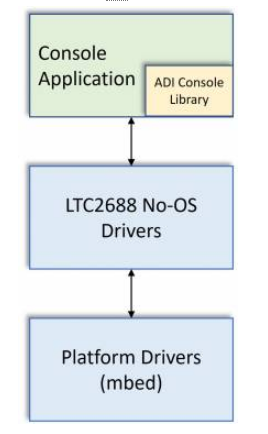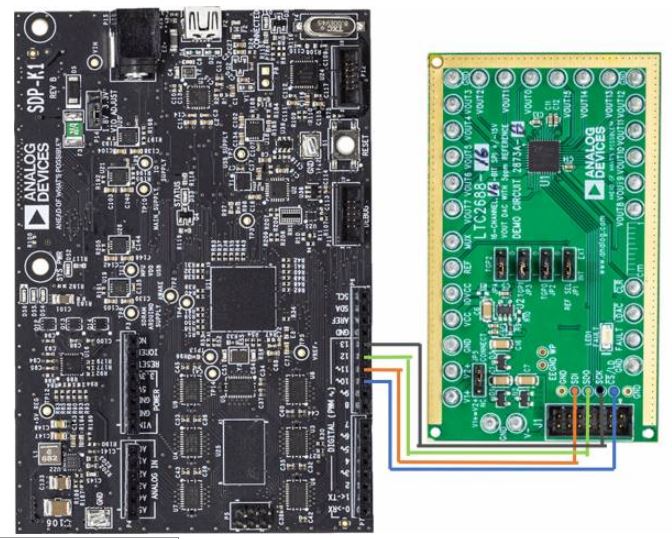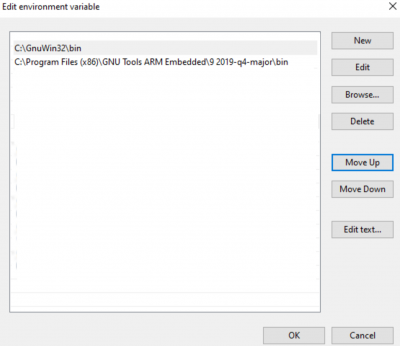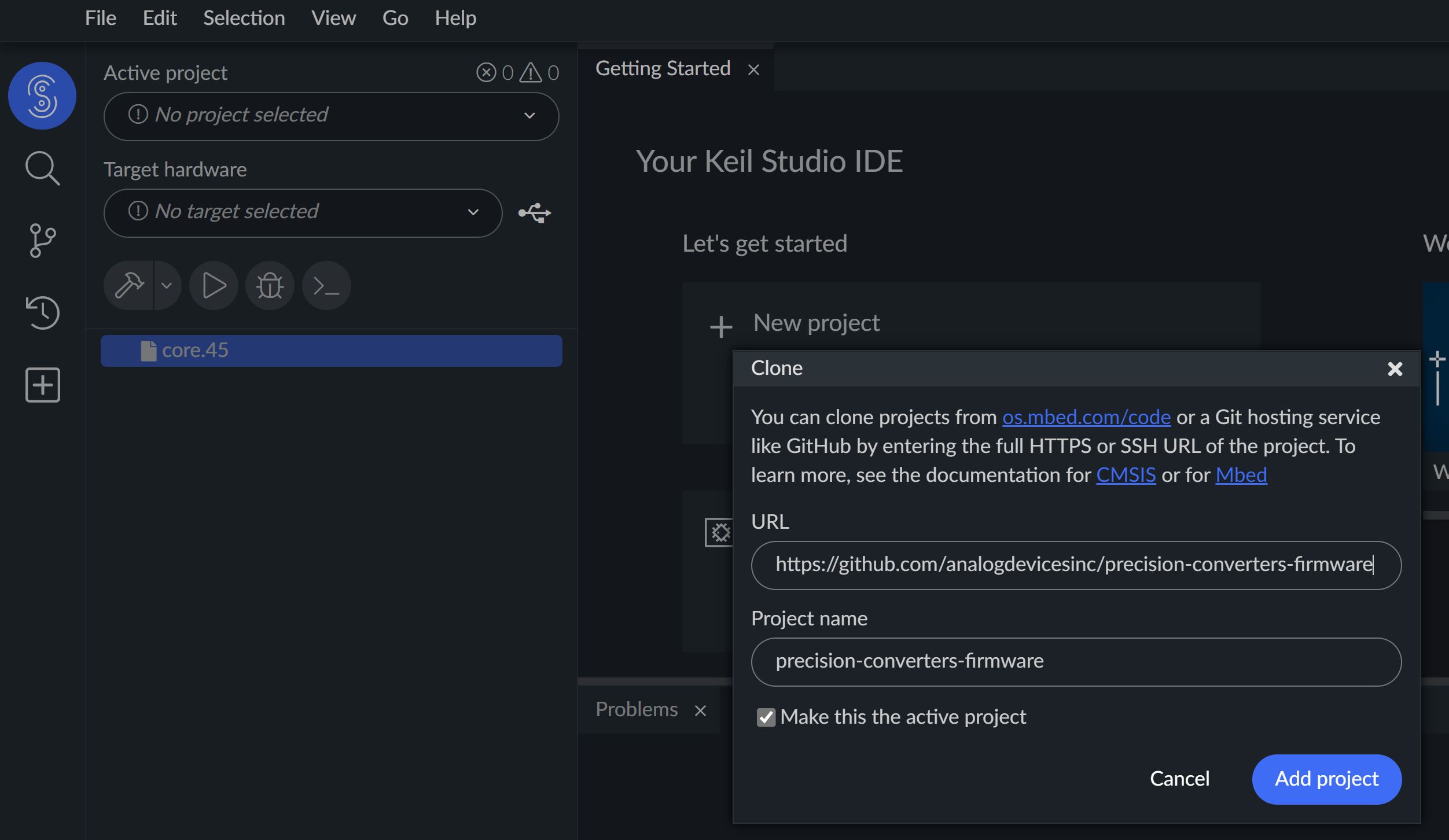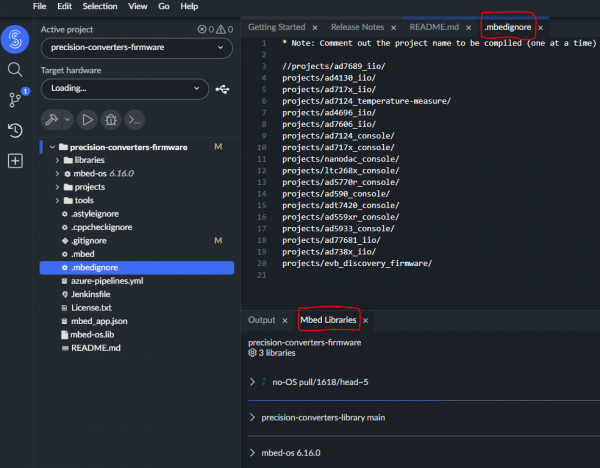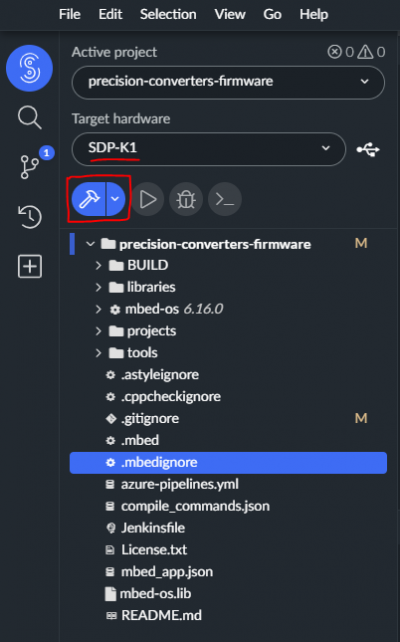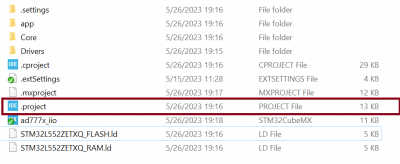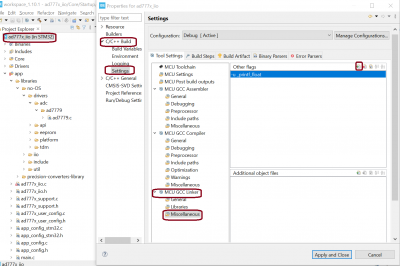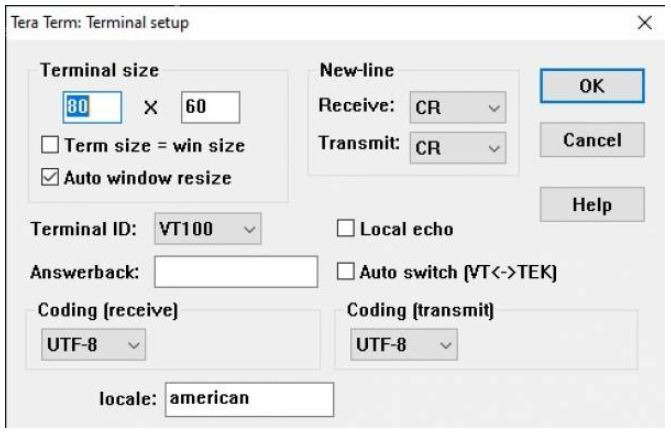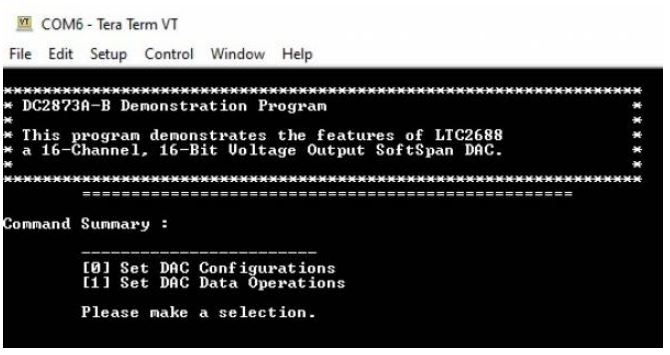LTC268x Console Application
Supported Hardware
Supported Devices:
Supported Evaluation Boards:
Supported Carrier Boards:
Introduction
The LTC2686/8 are 8/16-channel, 16-bit, ±15 V digital-to-analog converters (DAC) with an integrated precision reference. The LTC268X example software can be used as a starting point for developing your own code for Analog Devices DC2873A-B or DC2904A board in your own environment. This guide will focus interfacing the DC2873A-B or DC2904A-B evaluation board with Analog Devices SDP-K1 controller board or any an MBED-Enabled board (Or an STM32 board). The firmware example comprises 3 layers of software (from top to bottom): Console Application Layer, Device No-OS Layer and Platform Drivers layer.It supports Mbed and STM32 platforms
The application layer uses the ADI Console Libraries to create console-based User Interactive (UI). The middle layer of No-OS device library has device specific APIs to interface with LTC2686/8 devices. These APIs allows direct access to device register map in order to read/write device registers. The bottom layer of Platform Drivers is responsible for Low Level Interface. The platform drivers use underlying libraries to access low level peripheral (like GPIOs, SPI, I2C, etc). The devices from LTC2686/8 family use SPI communication interfaces respectively.
This guide focuses on the SDP-K1, connected to the DC2873A-B or DC2904A-B board, but it should be general enough to cover any compatible controller board (the controller board should be Mbed-enabled, and expose at least SPI or I2C and some GPIO’s). The Platform simplifies the overall software development process by providing the low level driver support. This reduces the hardware dependency as any Mbed enabled board (or an STM32 board) can be used with same firmware with little modifications (precisely changing a pin mapping).
The software described below allows for an Mbed enabled (Or an STM32 board) controller board to be connected with an Analog Devices evaluation board. Unmodified, the code will communicate over any serial terminal emulator (CoolTerm, putty, etc) using the UART provided by the controller board over USB.
Interface Diagram
The DC2873A-B/DC2904A-B evaluation board is connected to SDP-K1 using the Arduino Headers and jumper wires. The DC2873A-B/DC2904A-B evaluation board VCC and IOVCC can be powered-up through a SDP-K1 USB supply or from external DC supply using the turrets connection. The SDP-K1 is connected to PC through an USB cable. The firmware (binary executable) can be loaded into SDP-K1 board through this USB interface from the PC. The SDP-K1 acts as a Serial Device (UART) and firmware loaded into it interacts with any serial terminal (like Teraterm, Putty, Coolterm, etc) by configuring terminal for proper serial settings (COM Port, Baud Rate, data bits, etc)
Useful Links
Note
Linux and HDL are not used in emebdded IIO firmware projects but they may be of interest if you require Linux and/or FPGA support.
Hardware Connections
The DC2873A-B/DC2904A-B evaluation board can be connected to the SDP-K1 using jumper wires from the Arduino header to the signal pins available via through-hole headers right beside the J1 connector. Either you can solder header pins on the through-hole mounting area or directly connect wires to them.
The connections to be made between the SDP-K1 and the DC2873A-B/DC2904A-B are as follows:
SDP-K1 Arduino Header |
DC2873A-B/DC2904A-B Through-Hole |
SCLK/D13 |
SCK |
MISO/D12 |
SDO |
MOSI/D11 |
SDI |
CS/D10 |
CS |
GND |
GND |
Power Supply
The power to the evaluation board should be supplied through the on-board turret connections within the following supply range:
Pin |
Turret |
Voltage Supply |
VCC |
E31 |
5V |
IOVCC |
E10 |
3.3V |
V1+ |
E1 |
5V - 21V |
V2+ |
E14 |
5V - 21V |
V- |
E3 |
-21V - 0 |
GND |
E2 |
GND |
Note
V2+ must be less than or equal to V1+. The VIO_ADJUST jumper on the SDP-K1 board should be on 3.3V position. Remove the jumpers from JP1, JP2, JP3, JP4 for using the board with VIO = 3.3V
Build Guide
Build Prerequisites
Prior to building a firmware project, it is required to set up an environment so that the build process may find the necessary tools (compiler, linker, SDK etc.). Use the following steps to prepare your environment for building firmware projects for respective platform.
Visit Arm Keil website to create an user account for accessing the web based Keil Studio IDE.
Open Keil Studio Web IDE with registered user account
Clone Precision Converters Firmware repository with the –recursive flag (not needed if building with web IDE for Mbed platform):
git clone --recursive https://github.com/analogdevicesinc/precision-converters-firmware
If however you’ve already cloned the repository without the –recursive flag, you may initialize all the submodules in an existing cloned repo with:
git submodule update --recursive --init
Install Make in the root of ‘C’ drive without any spaces in the installation path. The path must be C:\GnuWin32\…. Add this path into the system environmental path variable (as shown in below screenshot).
Install Git and add a path of C:\Program Files\Git\usr\bin\ directory into system environmental path variable (please verify your git installation path is correct).
Install Mbed CLI 1 as per guide here.
Install GNU Arm Embedded compiler (for the development, 9-2019-q4-major version is used) and add a path of GNU Arm Embedded Toolchain bin directory into the system environmental path variable (as shown in below screenshot).
Configure the compiler location with Mbed CLI. This can be carried out by running the mbed config -G GCC_ARM_PATH <path-to-your-gcc-compiler> in Command Prompt. For example you can run mbed config -G GCC_ARM_PATH “C:\Program Files (x86)\GNU Tools ARM Embedded\9 2019-q4-major\bin” in command prompt. It will set mentioned compiler path to all the Mbed Projects.
Install STM32CubeIDE
Install STM32CubeMX
Building a project
Once the build enviornment is setup, follow the guide below to build your project and generate executable file (.bin/.hex)
Clone the Precision Converters Firmware repository into Keil Studio using “File->clone…” menu.
Once the project repository is imported, wait until all library dependencies are imported as shown in below screenshot. Now, open the ‘.medignore’ file present in the root directory of repository. Add comment syntax (two forward slashes) in front of the project name which you want to build. This will ignore all other projects and build only the comment syntax selected project.
Select the target device (default used for development is SDP-K1) and click on ‘Clean build’ option to build the project. After a successful build a binary will be downloaded to your computer- store this on your drive. Drag and drop this binary to the USB drive hosted by your controller board to flash the MCU.
Note
If you intend to build different project, then modify the .medignore file in the root directory as mentioned in step2 and clean build project as mentioned in step3
Open Git bash and change current directory to project directory (eg. precision-converters-firmware/projects/ad4130_iio directory) which you want to build.
Type make on the git bash command prompt to build a project.
After successful build, binary file will be created into the Project_Name/build directory.
If you want to clean build, type make reset on git bash command which deletes all generated build files for the given project.
Note
Default TARGET_BOARD is SDP_K1 and COMPILER is GCC_ARM. Current Make based build only support GCC_ARM Compiler.
By default project is built for “SDP_K1” Board and “GCC_ARM” Compiler. If you want to build for other Mbed Board, For example If you want to build the project for “DISCO_F769NI” Board then run make TARGET_BOARD=DISCO_F769NI command in git bash command prompt. If you want to clean build, run make reset TARGET_BOARD=DISCO_F769NI command to delete the generated build files for the given project.
Open the respective project directory by navigating into the “precision_converters_firmware/projects/” folder.
In the “STM32” folder present within the project directory, double click and open the .ioc file present within.
Click on the “Generate Code” option seen on the top right corner
Upon successful generation of drivers for the selected MCU, the autogenerated files would be seen in the same directory where the .ioc file was present. Double click and open the “.project” file seen in the list of files
After the project is loaded to the STM32CubeIDE, unfold the adxxxx_iio project seen in the project explorer, right click the “app” folder, select “Settings” under the “C/C++ Build” section on the left pane and un-check the “Exclude resources from build” checkbox. This would ensure that the project specific files are included by the build system
In order to choose STM32 platform in the firmware, select the “ACTIVE_PLATFORM” as “STM32_PLATFORM” in the app_config.h from the respective project. Alternately , add compiler flag “ACTIVE_PLATFORM=value of STM32_PLATFORM in app_config.h” for selecting stm32 platform.
Add compiler flags “-u _printf_float” to the project settings.
Program by clicking on the “Run adxxxx_iio” option seen or by performing a copy->paste option of the .hex file seen in the STM32/Debug folder
Running a project
Once the firmware build is successful and binary file is generated, copy the generated binary into USB drive hosted by your MCU board (e.g. USB drive hosted by the supported MCU board on windows). This will flash the binary file into MCU present on the controller board. Programming might vary based on the tools used for building a project. The ‘Project Build’ section above talks about this exception at the end of all build steps.
Quick Start
If you have some familiarity with the Mbed or STM32 platform, the following is a basic list of steps required to start running the code, see below for more detail:
Connect the evaluation-board to the Mbed-enabled controller board (or an STM32 board) using the Arduino connector and jumper wires.
Connect all the power supplies to the evaluation board as instructed in the hardware connection section.
Connect the controller board to your computer over USB. (Make sure that the VIO_ADJUST is set to 3.3 volts)
Follow the steps mentioned in the Build Guide section above.
- Start up a serial terminal emulator (e.g. Tera Term)
Find the com-port your controller board is connected on and select it.
Set the baud-rate for 230400 - other defaults should be fine.
Reset the controller board and connect.
Use the menu provided over the terminal window to access the evaluation board.
Using the Firmware
The firmware is delivered as a basic, text-based user-interface that operates through a UART on the controller board using the same USB cable that is used to flash the firmware to the boards. Any terminal-emulator should work, but it is not possible for Analog Devices to test everyone. It is necessary to connect a serial terminal-emulator to interact with the running firmware.
Here TeraTerm is used as an example, Analog Devices does not endorse any particular program for this, but TeraTerm works well and is made freely available, other terminals such as CoolTerm, or PuTTY will work.
Configure your serial terminal (Tera Term) for below settings:
Set the baud-rate for 230400, configure the console terminal settings as shown in the picture above and select the connected controller board’s COM port. If using TeraTerm, you should be able to keep the defaults, however adjustments may need to be made to how carriage return (CR) is handled in order for everything to display correctly.
The LTC268x console main menu looks like below (with Tera Term):
The software is designed to be straight forward to use and requires little explanation. The main menu provides two options:
DAC Configuration: This option lets to configure various DAC parameters such as active channel, span and toggle/dither selection.
DAC Data Operation: This option lets you set the output voltage for DAC channels.
It is hoped that the most features of the LTC2686/8 are coded, but it’s likely that some special functionality is not implemented.
Support
Feel free to ask questions in the EngineerZone
